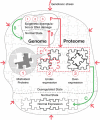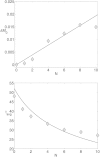Stability analysis of a model gene network links aging, stress resistance, and negligible senescence
- PMID: 26316217
- PMCID: PMC4551969
- DOI: 10.1038/srep13589
Stability analysis of a model gene network links aging, stress resistance, and negligible senescence
Abstract
Several animal species are considered to exhibit what is called negligible senescence, i.e. they do not show signs of functional decline or any increase of mortality with age. Recent studies in naked mole rat and long-lived sea urchins showed that these species do not alter their gene-expression profiles with age as much as other organisms do. This is consistent with exceptional endurance of naked mole rat tissues to various genotoxic stresses. We conjectured, therefore, that the lifelong transcriptional stability of an organism may be a key determinant of longevity. We analyzed the stability of a simple genetic-network model and found that under most common circumstances, such a gene network is inherently unstable. Over a time it undergoes an exponential accumulation of gene-regulation deviations leading to death. However, should the repair systems be sufficiently effective, the gene network can stabilize so that gene damage remains constrained along with mortality of the organism. We investigate the relationship between stress-resistance and aging and suggest that the unstable regime may provide a mathematical basis for the Gompertz "law" of aging in many species. At the same time, this model accounts for the apparently age-independent mortality observed in some exceptionally long-lived animals.
Figures




Similar articles
-
Unraveling the message: insights into comparative genomics of the naked mole-rat.Mamm Genome. 2016 Aug;27(7-8):259-78. doi: 10.1007/s00335-016-9648-5. Epub 2016 Jun 30. Mamm Genome. 2016. PMID: 27364349 Free PMC article. Review.
-
Beaver and Naked Mole Rat Genomes Reveal Common Paths to Longevity.Cell Rep. 2020 Jul 28;32(4):107949. doi: 10.1016/j.celrep.2020.107949. Cell Rep. 2020. PMID: 32726638 Free PMC article.
-
Naked mole-rat transcriptome signatures of socially suppressed sexual maturation and links of reproduction to aging.BMC Biol. 2018 Aug 2;16(1):77. doi: 10.1186/s12915-018-0546-z. BMC Biol. 2018. PMID: 30068345 Free PMC article.
-
Transcriptome analysis of a long-lived natural Drosophila variant: a prominent role of stress- and reproduction-genes in lifespan extension.BMC Genomics. 2012 May 4;13:167. doi: 10.1186/1471-2164-13-167. BMC Genomics. 2012. PMID: 22559237 Free PMC article.
-
The naked mole-rat response to oxidative stress: just deal with it.Antioxid Redox Signal. 2013 Oct 20;19(12):1388-99. doi: 10.1089/ars.2012.4911. Epub 2012 Dec 7. Antioxid Redox Signal. 2013. PMID: 23025341 Free PMC article. Review.
Cited by
-
A universal transcriptomic signature of age reveals the temporal scaling of Caenorhabditis elegans aging trajectories.Sci Rep. 2019 May 14;9(1):7368. doi: 10.1038/s41598-019-43075-z. Sci Rep. 2019. PMID: 31089188 Free PMC article.
-
Intercellular competition and the inevitability of multicellular aging.Proc Natl Acad Sci U S A. 2017 Dec 5;114(49):12982-12987. doi: 10.1073/pnas.1618854114. Epub 2017 Oct 30. Proc Natl Acad Sci U S A. 2017. PMID: 29087299 Free PMC article.
-
Unique age-related transcriptional signature in the nervous system of the long-lived red sea urchin Mesocentrotus franciscanus.Sci Rep. 2020 Jun 8;10(1):9182. doi: 10.1038/s41598-020-66052-3. Sci Rep. 2020. PMID: 32514014 Free PMC article.
-
Damage Repair versus Aging in an Individual-Based Model of Biofilms.mSystems. 2020 Oct 13;5(5):e00018-20. doi: 10.1128/mSystems.00018-20. mSystems. 2020. PMID: 33051374 Free PMC article.
-
Fountain of youth for squamous cell carcinomas? On the epigenetic age of non-small cell lung cancer and corresponding tumor-free lung tissues.Int J Cancer. 2018 Dec 15;143(12):3061-3070. doi: 10.1002/ijc.31641. Epub 2018 Oct 16. Int J Cancer. 2018. PMID: 29974462 Free PMC article.
References
-
- Finch C. E. Longevity, senescence, and the genome (University of Chicago Press, 1994).
-
- Abele D., Strahl J., Brey T. & Philipp E. E. Imperceptible senescence: ageing in the ocean quahog arctica islandica. Free Radical Res. 42, 474–480 (2008). - PubMed
-
- Congdon J., Nagle R., Kinney O. & van Loben Sels R. Hypotheses of aging in a long-lived vertebrate, blanding’s turtle (emydoidea blandingii). Exp. Gerontol. 36, 813–827 (2001). - PubMed
-
- Congdon J. D. et al. Testing hypotheses of aging in long-lived painted turtles (chrysemys picta). Exp. Gerontol. 38, 765–772 (2003). - PubMed
Publication types
MeSH terms
LinkOut - more resources
Full Text Sources
Other Literature Sources
Medical
Molecular Biology Databases
Miscellaneous

